
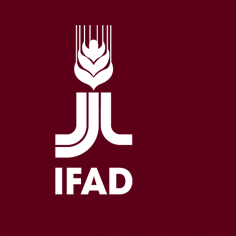
|
Sustainable natural resource management
Message from the director of the Asia and the Pacific Division The United Nations General Assembly has declared 2008 as the International Year of Planet Earth. Activities will span the three-year period from 2007 to 2009. With the growth of population and the high level of economic growth in the area, the livelihood models and economic choices of countries in the Asia and Pacific Region face the challenge of sustainability. Some of the choices made actually accelerate the depletion of the resources of the Earth that have made Asia’s success possible. They now exacerbate the risks posed to the Planet Earth and the sustainability of the livelihoods of its inhabitants. The risks related to sustainability are not confined within the borders of the region. Instead, they spill over throughout the rest of the world. And yet if we want to reach the Millennium Development Goals by 2015, the pace for poverty reduction in Asia and the Pacific can and must be increased through appropriate development choices that combine effective poverty reduction with the sustainability of the resource base itself. In the course of 2007, the Asia and Pacific Division will continue to work with its partners on knowledge management, policy dialogue, research and investment programming to promote innovation towards effective and durable choices for economic development and poverty reduction. In the knowledge sharing mode and with a view to mobilizing broader partnerships, most of the 2007 newsletters will address issues relevant to the Year of Planet Earth. This issue of the newsletter addresses the management of natural resources. The division is also planning to publish newsletters on sustainable development, reducing risks for society caused by natural and human-induced hazards, biodiversity and ecosystems, water for agriculture, trade, and national strategies for sustainable development. In the context of policy advocacy and country programme development, more explicit attention will be paid to advocating and promoting the Planet Earth issues, with poor rural people – productive women, indigenous peoples and youth – and their institutions naturally at the centre. Thomas Elhaut, director, Asia and the Pacific Division Improving management of inland fisheries resources in Bangladesh
IFAD undertook a project completion review of the Aquaculture Development Project in October 2006. The project was declared effective on 8 December 1998 and was completed on 30 June 2006. It focused on establishing and empowering beneficiary groups of men and of women, providing them with long-term security of tenure over productive natural water resources and building their capacity to improve their management of those resources. The review reported that the project succeeded in transferring control over 20 baors (large waterbodies) to community fishing groups, for a total area of 602 hectares. Despite the success, the actual transfer of control was a slow and difficult process. In four baors, all located in politically disturbed areas, it has not yet been possible for the lake fishing groups working with NGO and fishery officials to dislodge the local elites who still effectively control baor operations. The project has had considerable impact on poverty reduction and has improved food security. An impact study by the Bangladesh Institute for Development Studies showed that there has been a significant reduction in the proportion of beneficiary group households that are living below the poverty line (as defined by Bangladesh Bureau of Statistics).
Despite the project’s positive impact on reducing poverty and improving management of natural resources, sustainability is a concern. The review found that some groups were apprehensive about whether they could maintain control of their waterbodies in the face of pressure from vested interests and elites. Although the experience of the earlier Oxbow Lakes Small‑Scale Fishermen Project suggests that well-organized groups of fishermen can maintain control after the project ends, some fishermen still fear that pressures to usurp their control will grow after the coming national elections. Much will depend on the degree of support provided by the Department of Fisheries. It is a positive sign that in September 2006 the Department of Fisheries established a permanent jalmohal (waterbody)team, headed by a director, to support fisher groups in all such waterbodies. Two key lessons emerge from this approach to improving natural resource management. First, although improved management of baors results in a substantial increase in fish production, poverty can be reduced only if control of the baor is in the hands of genuine fishers. Second, the support of district administrative and fishery officials, as well as NGO facilitation, are essential in helping the group reduce the influence of local or external power elites and in establishing norms of cooperative behaviour and democratic functioning of lake fishing groups. Nigel Brett, country programme manager Read more about: Towards ‘gross national happiness’: promoting sustainable management of natural resources in Bhutan
The six-year Agriculture Marketing and Enterprise Promotion Programme is being implemented in eastern Bhutan. It is financed by an IFAD loan of US$13.9 million, an IFAD grant of US$100,000, technical assistance of US$1.6 million from the Dutch Development Organization (SNV), government counterpart funding of US$3.1 million and a contribution of about US$1.0 million from the people directly benefiting from the programme. The programme takes an environmentally sensitive programming and implementation approach towards its activities. It will address potential aspects of environmental fragility that may be associated with some technical proposals. For example, techniques used in constructing rural roads will adhere to the technical specifications known as Environment Friendly Road Construction (EFRC) developed and adopted by the Department of Roads, limiting negative effects on the natural environment. Other programme activities related to natural resource management include:
The programme will support niche crop production, establishment of bio-labels and trading, and cultivation of marketable non-timber forest products.
The programme’s livestock component is also likely to have favourable impacts on natural resources. It will work to replace current natural grazing practices with on-farm production and improved use of existing fodder resources, including crop residues. This would stimulate use of farm manure as an alternative to the increasing use of synthetic fertilizers in crop production. Through this practice livestock would be more closely associated with cropping systems, which would obtain a bio-label. Extension officers and focal persons in villages in the programme area will be trained in disseminating the environmentally friendly crop and livestock management techniques. In supporting rural enterprise development, the programme will ensure that environmental assessment is fully integrated into all business plans prepared by new entrepreneurs. The programme became effective on 14 June 2006 and is now on its way towards implementation. Martina Spisiakova, newsletter coordinator, and Riza Rosal, programme assistant Read more about: Assessing jhum with local communities: lessons from north-east India
The North Eastern Region Community Resource Management Project for Upland Areas assessed the jhum system through a process of social mobilization. In each project village it formed natural resource management groups (NaRMGs) that consisted of representatives from every household. Women members of the groups were further organized into self-help groups (SHGs). Working in partnership with participating NGOs, the local government and local village institutions, the project conducted capacity-building training to strengthen the groups’ human and social capital. Training addressed various ways to improve jhum systems, including diverse aspects of integrated upland farming systems and natural resource management. The review of the jhum system resulted in a set of interventions collectively termed ‘jhum modifications’. They included the following interventions:
Project interventions also promoted an integrated farming system through selection and support of lead farmers. Along with jhum modification activities, the integrated farming system included promotion of livestock raising, fisheries, apiculture, sericulture and home gardens. Large numbers of households in upland farming systems are now engaged in such multiple integrated activities. Communities were also mobilized to adopt conservation farming practices, particularly in jhum cultivation. These activities included:
In collaboration with the International Centre for Integrated Mountain Development (ICIMOD), the project also introduced the participatory three-dimensional model (P3DM) in some project villages. This has helped communities achieve better planning of natural resource management, including relocation of jhum fields.
K. Moses Chalai, project coordinator and Vincent Darlong, natural resource management and extension coordinator, North Eastern Region Community Resource Management Project for Upland Areas Read more about: International Centre for Integrated Mountain Development (ICIMOD) Legume production in Asia benefits natural resource management and reduces poverty
It is generally accepted that legumes play a vital role in rainfed agriculture by improving soil fertility and restoring soil health. While R&D has given increased attention to legumes in rainfed areas for many years, yield gains for legumes have been less spectacular than for cereals. National research and extension programmes have tended to focus on irrigated rather than rainfed areas. Even in the few instances where improved legume cultivars and improved crop management technologies have been developed, many farmers in rainfed areas have not benefited. This is because extension systems are not effective and seed from the improved varieties is not available because of inadequate seed production and/or marketing systems. In response, ICRISAT designed the three-year Programme for Farmer-Participatory Improvement of Grain Legumes in Rainfed Asia. Aware that IFAD was particularly concerned about small farmers in rainfed areas, ICRISAT applied to IFAD for a grant to cofinance the programme. The programme worked to improve the well-being of rural poor people engaged in rainfed agriculture through sustainably increased agricultural productivity. It focused on the adoption of grain legumes such as groundnut, chickpea, pigeon pea, and of related improved production technologies for rainfed cropping systems in China, India, Nepal and Viet Nam. The programme was completed in December 2006. During October 2006, an independent consultant with extensive experience in impact assessment carried out a review of the project. The consultant commented, “This is one of the most impressive projects the reviewer has evaluated in more than ten years of this type of work.” When commenting on environment, he stated that the environmental impacts of the technologies range from neutral to highly beneficial. The programme generated new crop varieties with an attractive income-generating potential. This resulted in an increased uptake of legume growing by farmers. The new varieties could also bring great benefits to soil fertility. Varieties made available to farmers by the programme through participatory plant breeding (PPB) and participatory varietal selection (PVS) processes are generally more resistant to pests and diseases than traditional ones. As a result, the application of chemical pesticides is being substantially reduced, as the area planted with the new varieties expands, benefiting the environment. One pest, the pigeon pea pod-borer (Helicoverpa armigera), remains a major threat, and plant breeding has not yet been successful in achieving genetic resistance to the pest. To date, there have been few alternatives other than chemical pesticides. But the legume programme has successfully promoted the use of non-chemical pesticides such as neem seed kernel extract in combination with the Helicoverpa nuclear polyhedrosis virus(HNPV). The neem tree grows throughout the region and kernel extract can be produced safely at home. A solution of HNPV is prepared by macerating dead pod-borer larvae in water. After confirming the efficacy of the neem+HNPV mixture, the programme established a number of pilot village-scale production units. Another approach that avoids the use of chemical pesticides has been tested and promoted by the programme. In Viet Nam, where the so-called army worm (Spodoptera) is a major pest, sunflowers are planted in groundnut fields as a trap crop. Army worms seem to prefer sunflower plants and will attack them rather than the groundnut plants, reducing the need to spray the plants with pesticides. The programme also has tested indigenous technologies that offer promising ways of avoiding the use of chemical pesticides. Treating chickpea seeds with linseed oil and with turpentine oil was found to be effective in combating root rot and nematodes. Similarly, adding chickpea straw seems to eliminate the need for chemicals to protect chickpeas during storage. The pigeon pea benefits the environment in general and the tree saplings in particular by fixing gaseous nitrogen in the nodules on their roots. The nodules eventually decompose to release nitrogenous compounds, adding to the soil’s fertility. Because pigeon pea is a new crop in southern China, the programme introduced recipes for its use as human food and for processing. Nepalese scientists who visited Yunnan Province to attend the annual Steering Committee of ICRISAT were so impressed by the programme that on their return home they planted demonstration plots to show how pigeon pea can be used to prevent soil erosion on steep slopes. Douglas Wholey, technical adviser, Technical Advisory Division Read more about: International Crops Research Institute for the Semi-Arid Tropics (ICRISAT)
Too good to be true? Rewards for environmental services can reduce poverty in the uplands of Asia
While forests are expected to provide environmental services and agriculture is expected to provide goods, the integrated landscape mosaic is no longer compact and no longer meets expectations For example, half of Indonesia’s 225 million people live in the urbanized lowlands, downstream from one fourth of the upland rural population, who farm and use the mosaic system, with small patches of forest. Rules to protect the forest continue to be enforced even though the forest no longer exists. As a result of those rules 50 million people in Indonesia live in contested landscapes without incentives to manage the resources well. Barriers that prevent the upland community from accessing land are a basic cause of persistent rural poverty. Conflicts over land use and an uneven voice in policy decisions characterize the relationship between upland and lowland communities. But as land managers upland communities have an important role in maintaining good environmental quality through their land practices. These services, usually known as environmental services, benefit lowland communities. The RUPES project led by a the ICRAF’s regional office in Indonesia shows that a positive mutual relationship between upland and lowland communities can be built. Replacement of conflict with recognition, rewards, shared responsibility and realistic, conditional and voluntary agreements can lead to substantial reduction of upland poverty and to sustainable natural resource management. Through its action research activities in six sites across Asia, to date ICRAF has identified eight pathways for poverty reduction, linked to different factors that determine poverty:
In the context of rural poverty and the environmental nexus the project’s key findings are that:
Meine van Noordwijk, regional coordinator for Southeast Asia, ICRAF and Beria Leimona, project coordinator, RUPES Read more about: Rewarding Upland Poor for Environmental Services (RUPES) Organic farming and biotechnology: do they help poor farmers?
Persistent rural poverty and natural resource degradation in less-favoured areas of South and East Asia have led some to advocate new agricultural technologies such as low external input sustainable agriculture approaches, purely organic farming, or genetically modified (GM) crops as an alternative to the chemically based technologies promoted during the Green Revolution. John Pender, a senior research fellow at IFPRI, examined evidence about the performance of new technologies in the region. While acknowledging the value of these innovative methods, Pender’s IFAD-supported study, Agricultural technology choices for poor farmers in less-favoured areas of South and East Asia, concludes that they do not work in all situations and warns against relying on them excessively. A review of the literature on the new approaches reveals that their success or failure depends on various ecological or social conditions. The agricultural technologies that will help poor farmers in remote mountain areas are different from those that will work in drylands or humid upland areas with favourable market access. Also, technologies that can readily be adopted by households with surplus labour availability may not be usable by labour-scarce households. Organic agriculture, for instance, has contributed to a significant increase in profitability and household incomes, and improved soil conditions. It has also contributed to the reduction of environmental risks for producers of some high value crops in areas with favourable market access. But it has had less impact for producers in more remote areas. Pender recommends less reliance on particular technologies on the part of researchers and technical assistance programmes. Instead, he recommends a more flexible approach to learning what works well, where and why. Approaches employed may involve exclusive use of organic agriculture, GM crops, low external input or sustainable agricultural approaches. Or they may involve combining them with older tools such as inorganic fertilizer. For example, in sloping dryland areas of China and India, integrated watershed development approaches such as water harvesting, recycling of soil nutrients through manuring and composting, and targeted use of inorganic fertilizer can improve natural resource management. New technologies can help reduce poverty and resource degradation in South and East Asia, but they must be based on an adequate diagnosis of farmers’ opportunities and constraints in particular situations. Further, they cannot perform effectively in isolation but depend on a prior framework of effective policies, institutions and rural organizations that benefit the region’s poor. John Whitehead, programme assistant, IFPRI International Food Policy Research Institute (IFPRI) Connecting poverty and the environment in PRSPs
Research from the Institute of Development Studies in the UK examines the process of including environmental factors in Poverty Reduction Strategy Papers (PRSPs) in Ghana, Honduras, Uganda and Viet Nam. All these countries have high poverty levels, with more than 20 per cent of the population living on less than US$1 per day. In all four countries, donors, government agencies and civil society organizations have had some success in promoting environmental issues in PRSPs. In Viet Nam, donors and the government have persuaded policymakers to include environmental issues in PRSPs. There has been limited civil society participation, although the media help create awareness of the links between the environment and poverty.
The capacity of governments to monitor environmental regulations is questionable and must improve. Governments must increase opportunities to include environmental indicators in PRSPs. To achieve this, they should:
Research highlight by id21 based on ‘Environment, Politics, and Poverty: Lessons from a Review of PRSP Stakeholder Perspectives’, Synthesis Review, Institute of Development Studies, by Linda Waldman, 2005 Read more about: Evolving environmental management: from conservation to poverty reduction Recent publications produced by the Asia and the Pacific grant programmes This section on grants publications and research results is intended to disseminate and communicate to a wider audience the outputs of the division’s grants programme. In 2006, the Asian NGO Coalition for Agrarian Reform and Rural Development (ANGOC) and the International Centre for Mountain Development (ICIMOD) issued publications on IFAD’s experience in building and strengthening rural poor people’s organizations, and debating shifting cultivation in Asia. Both publications were funded through IFAD regional grants. The Asia and the Pacific Division of IFAD operates through loan and grant programmes. The IFAD Policy for Grant Financing, approved by the Executive Board in 2003, presents new strategic objectives, allocation modalities and implementation procedures for IFAD-funded grants. Grant proposals may be country-specific, regional or international, depending on the nature of the innovation and impact envisaged. The IFAD grant programme has two strategic objectives that represent priority areas for IFAD’s regular grant resources:
The Asia and the Pacific Division’s grants programme currently comprises 12 large regional grants directly supervised by the division. They are implemented by CGIAR centres, international knowledge centres, NGOs and other multilateral organizations. The themes of large regional grants range from natural resource management and strengthening of rural poor people’s organizations to livestock production systems and support to policy dialogue. IFAD’s experience in building and strengthening rural poor organizations in Asia, ANGOC, 2006
This publication is the first output of the Strengthening Capacities of Organizations of the Poor – Experiences in Asia Project (SCOPE). The project is jointly implemented by ANGOC and the Center for Integrated Rural Development in Asia and the Pacific (CIRDAP), and it is sponsored by an IFAD regional grant. The SCOPE project is being implemented in five Asian countries, including Bangladesh, India, Indonesia, Mongolia and the Philippines. It works to increase the capacity of IFAD and its partners to:
One of the project activities is a review of IFAD project experiences in Asia in building organizations and coalitions of rural poor people over the past ten years. The publication examines the project formulation process and institution-building components of IFAD’s projects in Asia and the Pacific. In particular it looks at experiences in building organizations of rural poor people, reflecting on successes and failures, difficulties and challenges, and sustainability. The case studies draw particular lessons and provide suggestions and recommendations for IFAD. For more information about this publication, please contact Carla De Gregorio, grants coordinator, the Asia and the Pacific Division, IFAD, or Nathaniel Don Marquez, executive director, ANGOC Debating shifting cultivation in the eastern Himalayas: farmers’ innovations as lessons for policy, ICIMOD, compiled by E. Kerkhoff and E. Sharma, 2006
Using regional grant resources, IFAD supported the grant programme entitled Securing Livelihoods in Uplands and Mountains of the Hindu Kush-Himalayas, 2000-2005. The first phase of the programme and the IFAD-supported upland projects introduced innovative technical and institutional resource management methods. These complemented loan project efforts and facilitated an initiative that led to policy outcomes in natural resource management and specifically in the practice of shifting cultivation. This publication is one of the outcomes of the policy dialogue on shifting cultivation. It is a compilation of the findings of case studies and a debate conducted through the Jhumia Network – an e-network set up during the documentation and consultation process. The Jhumia network has become a permanent e-group for interchanges and experience sharing on shifting cultivation. It continues an active debate on diverse issues relevant to the practice. Most people see shifting cultivation as outdated and destructive, but it is still a preferred option for farmers in the eastern Himalayas. This study explains why. It shows that indigenous farmers have much to teach the world about the efficient use of their landscape for agriculture and forestry. Shifting cultivators conserve more forests on their land than any other farmers while maintaining crop productivity, avoiding soil degradation and conserving biodiversity. The publication contains important lessons for policy makers and development practitioners. The farmers' innovations can be applied to improving shifting cultivation and adapting it to modern needs, rather than replacing it with alternatives. The next newsletter, which will be published in March, will share the overall achievements of the ICIMOD grant titled Securing Livelihoods in Uplands and Mountains of the Hindu Kush-Himalayas. For more information, please contact Carla De Gregorio, grants coordinator, Asia and the Pacific Division, or Dhrupad Choudhury, Grant Programme, NRM Division, ICIMOD Read more about: Asian NGO Coalition for Agrarian Reform and Rural Development (ANGOC)
|
![]()
|
|
[email protected] Martina Spisiakova
Making a Difference in Asia and the Pacific Issue 13: November/December 2006 - PBAS: looking beyond the resource allocation system Issue 12: September/October 2006 - Communication for poverty reduction and rural development Issue 11: July/August 2006 - Working with UN agencies at the country level Issue 10: May/June 2006 - Indigenous peoples and ethnic minorities Issue 9: March/April 2006 - Access to land Issue 8: January/February 2006 - Agricultural Technology Management Issue 7: November/December 2005 - Pro-poor policies Issue 6: September/October 2005 - Gender & MDGs Issue 5: July/August 2005 - Partnership Issue 4: May/June 2005 - Rural Finance Issue 3: March/ April 2005 - Donor Harmonization Issue 2: January/ February 2005 Issue 1: November/ December 2004
China Mongolia
Evaluation of the regional gender mainstreaming programme to India, China, Cambodia and Sri Lanka, 23 January to 7 February 2007 Annual Work Plan and Budget 2007 preparation workshop in Bangladesh and Pakistan, 5 -16 February 2007 Bangladesh Mongolia Nepal Pakistan
Third International Conference on Environmental, Cultural, Economic and Social Sustainability, University of Madras, Chennai, India, 4 - 7 January 2007 International Conference on Simulation and Modeling: Towards Sustainable Livelihood and Environment, Chiang Mai Thailand, 9 January 2007 Hyderabad Sustainable Development Conference, Hyderabad, India, 13 - 14 January 2007 Delhi Sustainable Development Summit 2007, New Delhi, India, 22 - 24 January 2007 International Dialogue on Science and Practice in Sustainable Development: Linking Knowledge with Action, Chiang Mai, Thailand, 23 - 27 January 2007 Environment 2007 International Conference, Abu Dhabi, United Arab Emirates, 28 - 31 January 2007 Water Saving in Mediterranean Agriculture and Future Research Needs, Bari, Italy, 14 to 17 February 2007 International Conference on Sustainable Agriculture for Food, Bio-Energy and Livelihood Security, Jabalpur, Madhya Pradesh, India, 14 to 16 February 2007 The International Conference on the Environment : Survival and Sustainability, Nicosia Cyprus, 19 to 24 February 2007 International Conference on Sustainable Regional Development: Status, Challenges, Visions - from the Perspective of Northeast India, Gangtok India, 22 to 24 February 2007 National Conference on Technology for Sustainable Use of Natural Resources (TECH SUNR 2007) Parlakhemundi, India, 24 to 25 February 2007 Csd-15 Intergovernmental Preparatory Meeting, New York, United States of America, 26 February - 2 March 2007 51st Session of the UN Commission on the Status of Women (CSW), United Nations Headquarters, New York, United States of America, 26 February - 9 March 2007 |
![]()
The International Fund for Agricultural Development (IFAD) is a specialized agency of the United Nations, dedicated to eradicating poverty and hunger in developing countries. Its work in remote rural areas of the world helps countries achieve the Millennium Development Goals. Through low-interest loans and grants, IFAD develops and finances projects that enable rural poor people to overcome poverty themselves.
IFAD tackles poverty not just as a lender, but as an advocate for the small farmers, herders, fisherfolk, landless workers, artisans and indigenous peoples who live in rural areas and represent 75 per cent of the world's 1.2 billion extremely poor people. IFAD works with governments, donors, non-governmental organizations, local communities and many other partners to fight the underlying causes of rural poverty. It acts as a catalyst, bringing together partners, resources, knowledge and policies that create the conditions in which rural poor people can increase agricultural productivity, as well as seek out other options for earning income.
IFAD-supported rural development programmes and projects increase rural poor people's access to financial services, markets, technology, land and other natural resources.
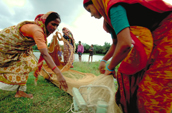 Sustainable management of inland capture fisheries in Bangladesh is a huge challenge. Lessons emerging from a recently completed IFAD-financed project point to two key elements of success. First, to succeed in improving resource management and reducing poverty at the same time genuinely poor fishermen need to be empowered to control the resource base. Second, strong support for fishing groups is needed to protect them from powerful local elites.
Sustainable management of inland capture fisheries in Bangladesh is a huge challenge. Lessons emerging from a recently completed IFAD-financed project point to two key elements of success. First, to succeed in improving resource management and reducing poverty at the same time genuinely poor fishermen need to be empowered to control the resource base. Second, strong support for fishing groups is needed to protect them from powerful local elites. 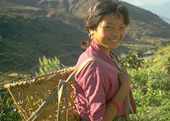 Bhutan’s overarching development philosophy is ‘gross national happiness’ (GNH). It recognizes the need to balance material well-being with the spiritual, emotional and cultural well-being of the individual and of society, for holistic development. As one of the four pillars of GNH, preservation and sustainable use of natural resources is central to every development initiative in Bhutan. To support Bhutan’s national process of rural poverty reduction, IFAD works to integrate sustainable natural resource management into the US$19.6 million Agriculture Marketing and Enterprise Promotion Programme.
Bhutan’s overarching development philosophy is ‘gross national happiness’ (GNH). It recognizes the need to balance material well-being with the spiritual, emotional and cultural well-being of the individual and of society, for holistic development. As one of the four pillars of GNH, preservation and sustainable use of natural resources is central to every development initiative in Bhutan. To support Bhutan’s national process of rural poverty reduction, IFAD works to integrate sustainable natural resource management into the US$19.6 million Agriculture Marketing and Enterprise Promotion Programme. Shifting cultivation, known as jhum or jhumming, is the most common system of upland land use and farming in north-east India. The IFAD-funded North Eastern Region Community Resource Management Project for Upland Areas is working in 860 villages where shifting cultivation is predominant. Experiences in most of the villages, such as a decreasing jhum cycle, declining crop yield, degradation of the environment and resulting food insecurity and poverty led to a rethinking of the jhum system.
Shifting cultivation, known as jhum or jhumming, is the most common system of upland land use and farming in north-east India. The IFAD-funded North Eastern Region Community Resource Management Project for Upland Areas is working in 860 villages where shifting cultivation is predominant. Experiences in most of the villages, such as a decreasing jhum cycle, declining crop yield, degradation of the environment and resulting food insecurity and poverty led to a rethinking of the jhum system. Small farmers living in rainfed areas of the Asia and the Pacific Region could benefit increasingly from improved crop management technologies if research and development (R&D) focused on these areas. To offset inadequate research in rainfed areas, IFAD provided a US$1.3 million grant to finance theProgramme for Farmer-Participatory Improvement of Grain Legumes in Rainfed Asia designed and implemented by the International Crops Research Institute for the Semi-Arid Tropics (ICRISAT). Among other findings, the programme shows that improved legume production can reduce poverty and at the same time improve the management of natural resources.
Small farmers living in rainfed areas of the Asia and the Pacific Region could benefit increasingly from improved crop management technologies if research and development (R&D) focused on these areas. To offset inadequate research in rainfed areas, IFAD provided a US$1.3 million grant to finance theProgramme for Farmer-Participatory Improvement of Grain Legumes in Rainfed Asia designed and implemented by the International Crops Research Institute for the Semi-Arid Tropics (ICRISAT). Among other findings, the programme shows that improved legume production can reduce poverty and at the same time improve the management of natural resources.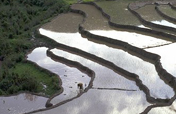 Lowland rice agro-ecosystems and urbanized communities have contributed significantly to increased welfare across Asia. But while these systems and communities depend on increased environmental goods and services, which are usually provided by upland areas, the supply is actually dwindling. Changes in land use to produce more ‘goods’ tends to reduce ‘services’. The IFAD-funded Project for Rewarding Upland Poor for Environmental Services (RUPES), implemented by the World Agroforestry Centre (ICRAF), shows that rewards for and shared responsibility over the management of natural resources can reduce poverty and protect the environment.
Lowland rice agro-ecosystems and urbanized communities have contributed significantly to increased welfare across Asia. But while these systems and communities depend on increased environmental goods and services, which are usually provided by upland areas, the supply is actually dwindling. Changes in land use to produce more ‘goods’ tends to reduce ‘services’. The IFAD-funded Project for Rewarding Upland Poor for Environmental Services (RUPES), implemented by the World Agroforestry Centre (ICRAF), shows that rewards for and shared responsibility over the management of natural resources can reduce poverty and protect the environment.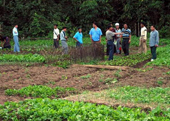 Recent research conducted by the International Food Policy Research Institute (IFPRI), supported by IFAD, shows that organic farming and biotechnology can help reduce poverty and resource degradation in South and East Asia. But their use must be based on adequate analysis of the economic and environmental context in which they will be applied. What works well in one place might not work in another.
Recent research conducted by the International Food Policy Research Institute (IFPRI), supported by IFAD, shows that organic farming and biotechnology can help reduce poverty and resource degradation in South and East Asia. But their use must be based on adequate analysis of the economic and environmental context in which they will be applied. What works well in one place might not work in another. 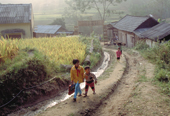 Poverty Reduction Strategy Papers (PRSPs) increasingly link poverty with the environment. However, many of them avoid tackling difficult or political aspects of environmental management. How can PRSPs improve people’s livelihoods and ensure the sustainable use of natural resources?
Poverty Reduction Strategy Papers (PRSPs) increasingly link poverty with the environment. However, many of them avoid tackling difficult or political aspects of environmental management. How can PRSPs improve people’s livelihoods and ensure the sustainable use of natural resources?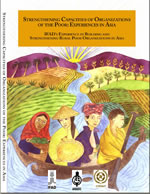 ANGOC recently issued a new publication entitled
ANGOC recently issued a new publication entitled 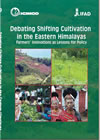 IFAD has supported several loan investment projects in the uplands and mountains of the Hindu Kush Himalayan countries with specific attention to the unique nature of upland and mountain areas. To provide strategic support and complement the efforts made through loan investment projects, IFAD mandated the International Centre for Integrated Mountain Development (ICIMOD) to provide the necessary technical backstopping based on its expertise and knowledge resources. ICIMOD also has a potential for cross-linking between projects, collaborative partners and regional member country governments.
IFAD has supported several loan investment projects in the uplands and mountains of the Hindu Kush Himalayan countries with specific attention to the unique nature of upland and mountain areas. To provide strategic support and complement the efforts made through loan investment projects, IFAD mandated the International Centre for Integrated Mountain Development (ICIMOD) to provide the necessary technical backstopping based on its expertise and knowledge resources. ICIMOD also has a potential for cross-linking between projects, collaborative partners and regional member country governments.